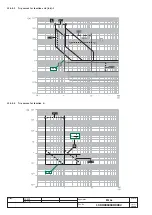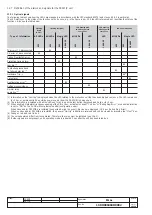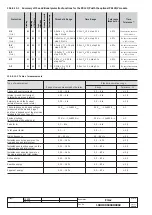
L2234
Emax
48/158
Model
Scale
Page No.
Doc. No.
Apparatus
1SDH000460R0002
L2778
13.2.9.8 Load control function
Single loads can be enabled/disabled on the load side before the overload protection L intervenes and trips the circuit-breaker on the supply
side. This is done by contactors or switch-disconnectors (wired outside the release), controlled by the PR122/P by means of contacts on the PR120/
K module or on the PR021/K external unit.
The current thresholds are lower than those available with the protection L, so that the load control can be used to prevent tripping due to overloads.
The function is active when an auxiliary power supply is present, or supply from PR120/V (see par. 15.1.4)
The operating logic involves the activation of three contacts when the preset thresholds LC1, LC2 and I
w
are exceeded.
Thresholds LC1 and LC2 are expressed as a percentage of I
1
(current threshold specified for protection L) while the "warning current" I
w
is expressed
as an absolute value. The allowable values are given in the following table:
Warning current Iw
0.30 ÷ 10.0 step 0.05xIn
Threshold LC1
50% ÷ 100% step 1% xI
1
Threshold LC2
50% ÷ 100% step 1% xI
1
From the PR122/P you can associate each of the PR120/K or PR121/K contacts with a configuration (NO or NC), a delay and the eventual latch.
13.2.9.9
Voltage protections "UV", "OV", "RV", "U" (PROTECTIONS AVAILABLE ONLY WITH THE ADDITIONAL PR120/V MODULE)
The PR122/P unit provides 4 voltage protections, which can be disabled, with fixed adjustable time (t = k), active both with self-supply and with
auxiliary supply:
– Undervoltage "UV"
– Overvoltage "OV"
– Residual voltage "RV"
– Line voltage unbalance “U”.
Apart from normal timing and "Trip" operation, the voltage protections can be in a state defined as "alarm" (with the "emergency" led on and an
alarm message displayed) providing there is an auxiliary or PR120/V module power supply. In fact, in the case where the circuit-breaker is open
and no current is detected, the timing leads to the "alarm" state and not to "TRIP". This is because the fault linked to the voltages can persist even
with the circuit-breaker open. When the circuit-breaker is closed or the passage of a current is detected, you pass immediately from the state
of "alarm" to "TRIP" without timing (see par. 13.3.2).
13.2.9.9.1 Protection “UV”
When the minimum phase voltage drops below the set threshold U
8
the protection counts down the preset time interval t
8
and then opens.
13.2.9.9.2 Protection “OV”
When the maximum phase voltage exceeds the set threshold U
9
the protection counts down the preset time interval t
9
and then opens.
13.2.9.9.3 Protection “RV”
When the residual voltage exceeds the set threshold U
10
the protection counts down the preset time interval t
10
and then opens.
The residual voltage U
0
is calculated by vectorially summing the phase voltages. It is therefore defined by the following formula.
This protection is available on 4-pole or 3-pole CBs with neutral voltage available (as per circuit diagram 48 on page 153). On 3-pole CBs, presence
of neutral voltage must be set by the “neutral voltage present” parameter.
13.2.9.9.4 Protection “U”
The disable-type, fixed-time protection trips when - for a time higher than or equal to
t6
time set - an unbalance between two or more line voltages
greater than
I6
, is detected. Range: 2 … 90% by 1% steps.
Unbalance percentage is calculated as follows
)
,
,
(
)
,
,
(
.
31
23
12
1
31
23
12
1
V
V
V
d
mean
V
V
V
d
mean
from
deviation
Max
unbalance
Voltage
=
.
13.2.9.10 Reverse active power protection "RP"(AVAILABLE ONLY WITH THE ADDITIONAL PR120/V MODULE)
The PR122/P unit provides protection (which can be disabled) with an adjustable fixed time (t = k), against reverse active power, active both with
self-supply and auxiliary supply.
When the total reverse active power (sum of the power of the 3 phases) exceeds the set reverse active power threshold P
11
, the protection counts
down the preset time interval t
11
and then opens.
The minus sign ('-') in front of the threshold and power indicates reverse power. The threshold is indicated as a percentage of "Pn", where "Pn"
is the rated power of the circuit-breaker (3 Vn*In).
13.2.9.11 Frequency protections "UF", "OF"(AVAILABLE ONLY WITH THE ADDITIONAL PR120/V MODULE)
The frequency protections record the mains frequency variations above an adjustable threshold (f
12
, t
12
) or below (f
13
, t
13
), generating an alarm
or the opening of the circuit-breaker.
3
2
1
0
U
U
U
U
+
+
=














































